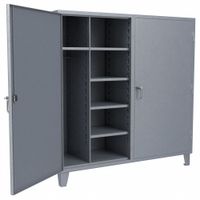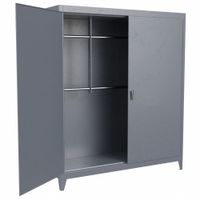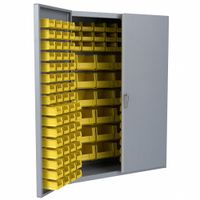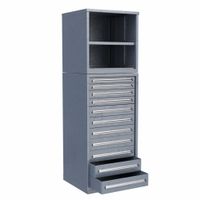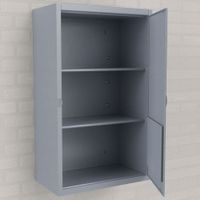Call +(254) 703 030 000 / 751 483 999 / 721 704 777
- Home
- Material Handling
- Storage Workspace
- Storage Cabinets
.....Read More
Frequently Asked Questions
What are the best materials for storage cabinets?
The best materials for storage cabinets depend on factors like durability, aesthetics, cost, and intended use. Here are some top choices:
1. **Solid Wood**: Known for its durability and classic appeal, solid wood like oak, maple, or cherry is ideal for high-end cabinets. It offers a timeless look and can be refinished, but it is more expensive and susceptible to warping in humid conditions.
2. **Plywood**: A strong and stable option, plywood is made from layers of wood veneer. It resists warping and is more affordable than solid wood, making it a popular choice for both residential and commercial cabinets.
3. **Medium-Density Fiberboard (MDF)**: MDF is a cost-effective and smooth material made from wood fibers and resin. It is easy to paint and provides a sleek finish, but it is less durable than plywood and can swell if exposed to moisture.
4. **Particleboard**: Composed of wood chips and resin, particleboard is an economical choice for budget-friendly cabinets. It is less durable than plywood and MDF, but it can be veneered or laminated for a better appearance.
5. **Metal**: Often used in industrial or modern settings, metal cabinets (like stainless steel or aluminum) are durable, resistant to moisture, and easy to clean. They are ideal for kitchens, garages, or outdoor use but can be more expensive and heavier.
6. **Laminate**: Made by pressing layers of paper or fabric with resin, laminate is applied over MDF or particleboard. It offers a wide range of colors and patterns, is easy to clean, and is resistant to scratches and stains.
7. **Thermofoil**: A vinyl film applied to MDF, thermofoil provides a smooth, easy-to-clean surface. It mimics the look of painted wood but can peel over time if exposed to heat or moisture.
Choosing the right material depends on balancing these factors to meet your specific needs and preferences.
How do I choose the right size storage cabinet?
To choose the right size storage cabinet, start by assessing your storage needs. Determine what items you plan to store and their dimensions. Measure the available space where the cabinet will be placed, considering height, width, and depth, and ensure there's enough room for doors or drawers to open fully. Consider the cabinet's purpose: for general storage, a larger cabinet with adjustable shelves might be ideal, while for specific items like files or tools, a cabinet with specialized compartments may be better.
Evaluate the weight capacity required, especially if storing heavy items, and ensure the cabinet's material and construction can support this. Think about future needs; opting for a slightly larger cabinet can accommodate growth. Consider the room's layout and traffic flow to avoid obstructing pathways. If space is limited, vertical cabinets can maximize storage without taking up much floor space.
Factor in the cabinet's style and design to match your room's decor. For shared spaces, consider lockable cabinets for security. If mobility is important, look for cabinets with wheels. Finally, set a budget, balancing cost with quality and durability. By considering these factors, you can select a storage cabinet that meets your needs efficiently.
What features should I look for in a storage cabinet?
When selecting a storage cabinet, consider the following features:
1. **Material**: Choose between metal, wood, or plastic based on durability, aesthetics, and intended use. Metal is sturdy and secure, wood offers a classic look, and plastic is lightweight and moisture-resistant.
2. **Size and Capacity**: Ensure the cabinet fits your space and meets your storage needs. Consider both the external dimensions and internal capacity.
3. **Adjustable Shelves**: Look for cabinets with adjustable shelves to accommodate items of various sizes and maximize storage efficiency.
4. **Locking Mechanism**: For security, especially if storing valuable or sensitive items, opt for cabinets with reliable locking systems.
5. **Weight Capacity**: Check the weight limit of shelves to ensure they can support your items without sagging or breaking.
6. **Design and Aesthetics**: Choose a design that complements your existing decor, whether modern, traditional, or industrial.
7. **Ease of Assembly**: Consider how easy it is to assemble the cabinet, especially if you plan to do it yourself. Look for clear instructions and necessary tools included.
8. **Mobility**: If you need to move the cabinet frequently, consider one with wheels or casters for easy relocation.
9. **Ventilation**: For storing items that require air circulation, such as electronics or chemicals, look for cabinets with ventilation features.
10. **Water and Fire Resistance**: For added protection, especially in environments prone to moisture or fire hazards, consider cabinets with water and fire-resistant properties.
11. **Warranty and Brand Reputation**: Check for a warranty and research the brand's reputation for quality and customer service.
12. **Price**: Ensure the cabinet fits within your budget while meeting your quality and feature requirements.
How do I organize tools and equipment in a storage cabinet?
To organize tools and equipment in a storage cabinet, start by categorizing items based on their function or frequency of use. Group similar tools together, such as hand tools, power tools, and accessories. Use drawer organizers or bins to separate smaller items like screws, nails, and drill bits. Label each bin or drawer for easy identification.
Install pegboards or magnetic strips on the cabinet doors or walls to hang frequently used tools, keeping them visible and accessible. Use hooks or brackets for larger tools like hammers or wrenches. Consider adjustable shelving to accommodate tools of varying sizes and to maximize vertical space.
For power tools, designate a specific shelf or section, ensuring they are stored with their cords neatly coiled or secured. If possible, keep power tools in their original cases for protection and easy stacking.
Utilize clear plastic containers for visibility, and stack them to save space. Ensure heavier items are stored on lower shelves to prevent tipping and for safety. Keep a small toolbox or caddy for essential tools that you use regularly, allowing for easy transport.
Regularly declutter the cabinet by removing duplicate or rarely used items. Maintain an inventory list to track tools and equipment, ensuring everything is returned to its designated spot after use. This system not only keeps your storage cabinet organized but also extends the life of your tools by preventing damage and loss.
Are there specific storage cabinets for different industries?
Yes, different industries often require specific storage cabinets tailored to their unique needs.
1. **Healthcare Industry**: Medical storage cabinets are designed to store medications, medical supplies, and equipment. They often include features like lockable doors for security, temperature control for sensitive items, and easy-to-clean surfaces to maintain hygiene.
2. **Food and Beverage Industry**: These cabinets are typically made from stainless steel to prevent contamination and are designed to store ingredients, utensils, and equipment. They may include refrigeration units for perishable items and are often compliant with food safety regulations.
3. **Pharmaceutical Industry**: Cabinets in this sector are used for storing chemicals, drugs, and laboratory equipment. They often have features like chemical resistance, secure locking mechanisms, and controlled environments to ensure the integrity of the stored items.
4. **Manufacturing Industry**: Storage cabinets here are used for tools, parts, and raw materials. They are often heavy-duty, with features like adjustable shelving, high weight capacity, and sometimes mobility for easy access on the production floor.
5. **Automotive Industry**: These cabinets are designed to store tools, parts, and lubricants. They are typically robust, with features like pegboards for tool organization, drawers for small parts, and oil-resistant surfaces.
6. **Chemical Industry**: Cabinets for this industry are designed to safely store hazardous materials. They often include features like ventilation, fire resistance, and spill containment to prevent accidents and ensure compliance with safety regulations.
7. **Retail Industry**: Storage solutions here are used for inventory management. They often include adjustable shelving, lockable doors, and are designed to maximize space efficiency.
Each industry has specific requirements that dictate the design and features of storage cabinets to ensure safety, efficiency, and compliance with relevant regulations.
How do I maintain and clean storage cabinets?
To maintain and clean storage cabinets, follow these steps:
1. **Empty the Cabinets**: Remove all items to access every corner. This also allows you to assess what you have and declutter.
2. **Dust and Vacuum**: Use a microfiber cloth to dust shelves and corners. For hard-to-reach areas, use a vacuum with a brush attachment.
3. **Clean Surfaces**: Mix warm water with mild dish soap. Dampen a cloth and wipe down all surfaces, including shelves, doors, and handles. For stubborn stains, use a baking soda paste.
4. **Rinse and Dry**: Wipe surfaces with a clean, damp cloth to remove soap residue. Dry thoroughly with a towel to prevent moisture damage.
5. **Inspect for Damage**: Check for signs of wear, such as loose hinges or peeling paint. Tighten screws and touch up paint as needed.
6. **Organize Items**: Sort items by category and frequency of use. Consider using bins or baskets for better organization.
7. **Use Liners**: Place shelf liners to protect surfaces from spills and scratches. They also make future cleaning easier.
8. **Maintain Regularly**: Schedule regular cleaning, ideally every few months, to prevent buildup of dust and grime.
9. **Control Humidity**: Use dehumidifiers or silica gel packs to prevent mold and mildew, especially in humid areas.
10. **Avoid Overloading**: Do not overfill cabinets to prevent damage and ensure easy access to items.
By following these steps, you can keep your storage cabinets clean, organized, and in good condition.
What are the security options for storage cabinets?
Security options for storage cabinets include:
1. **Lock and Key Systems**: Traditional and widely used, these systems involve a physical key to lock and unlock the cabinet. Variations include cam locks, deadbolt locks, and padlocks.
2. **Combination Locks**: These locks require a numerical code to open, eliminating the need for keys. They can be mechanical or digital, with digital versions offering features like resettable codes.
3. **Electronic Keypad Locks**: These locks use a keypad for code entry, offering convenience and eliminating the need for physical keys. They often include features like multiple user codes and audit trails.
4. **Biometric Locks**: Utilizing fingerprint or retinal scans, these locks provide high security by ensuring only authorized individuals can access the cabinet.
5. **RFID Locks**: Radio Frequency Identification (RFID) locks use cards or fobs to unlock, offering a keyless entry solution. They are often used in environments requiring frequent access.
6. **Smart Locks**: Connected via Bluetooth or Wi-Fi, smart locks can be controlled remotely through smartphones or computers. They offer features like real-time access logs and temporary access codes.
7. **Tamper-Evident Seals**: These seals provide a visual indication if a cabinet has been accessed or tampered with, serving as a deterrent and alerting to unauthorized access.
8. **Reinforced Construction**: Cabinets made from heavy-duty materials like steel provide physical security against break-ins and tampering.
9. **Alarm Systems**: Integrated alarms can alert users to unauthorized access attempts, either through audible alarms or notifications to a connected device.
10. **Surveillance Cameras**: Installing cameras near storage cabinets can deter unauthorized access and provide evidence in case of a security breach.
11. **Access Control Systems**: These systems manage who can access the cabinets, often integrating with other security measures like keycards or biometric systems for enhanced control.
